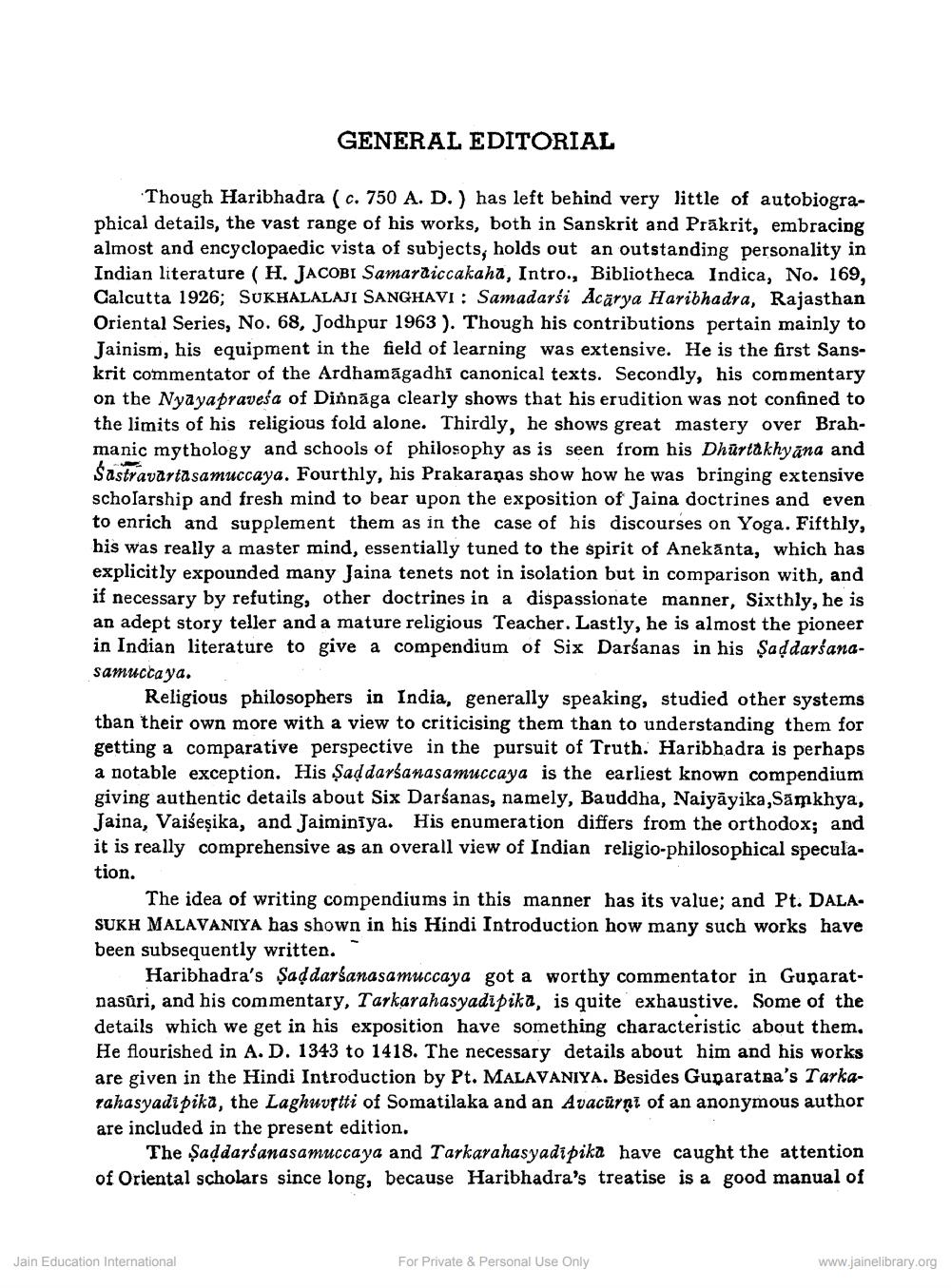________________
GENERAL EDITORIAL
Though Haribhadra (c. 750 A. D.) has left behind very little of autobiographical details, the vast range of his works, both in Sanskrit and Präkrit, embracing almost and encyclopaedic vista of subjects, holds out an outstanding personality in Indian literature (H. JACOBI Samardiccakaha, Intro., Bibliotheca Indica, No. 169, Calcutta 1926; SUKHALALAJI SANGHAVI : Samadarsi Acarya Haribhadra, Rajasthan Oriental Series, No. 68, Jodhpur 1963 ). Though his contributions pertain mainly to Jainism, his equipment in the field of learning was extensive. He is the first Sanskrit commentator of the Ardhamāgadhĩ canonical texts. Secondly, his commentary on the Nyayapraveśa of Dinnāga clearly shows that his erudition was not confined to the limits of his religious fold alone. Thirdly, he shows great mastery over Brahmanic mythology and schools of philosophy as is seen from his Dhūrtakhyana and Sastravartā samuccaya. Fourthly, his Prakaranas show how he was bringing extensive scholarship and fresh mind to bear upon the exposition of Jaina doctrines and even to enrich and supplement them as in the case of his discourses on Yoga. Fifthly, his was really a master mind, essentially tuned to the spirit of Anekanta, which has explicitly expounded many Jaina tenets not in isolation but in comparison with, and if necessary by refuting, other doctrines in a dispassionate manner, Sixthly, he is an adept story teller and a mature religious Teacher. Lastly, he is almost the pioneer in Indian literature to give a compendium of Six Darśanas in his Şaddarśanasamucca ya.
Religious philosophers in India, generally speaking, studied other systems than their own more with a view to criticising them than to understanding them for getting a comparative perspective in the pursuit of Truth. Haribhadra is perhaps a notable exception. His Şaddarśanasamuccaya is the earliest known compendium giving authentic details about Six Darśanas, namely, Bauddha, Naiyāyika, Samkhya, Jaina, Vaišeşika, and Jaiminiya. His enumeration differs from the orthodox; and it is really comprehensive as an overall view of Indian religio-philosophical speculation.
The idea of writing compendiums in this manner has its value; and Pt. DALA. SUKH MALAVANIYA has shown in his Hindi Introduction how many such works have been subsequently written.
Haribhadra's $addarśanasamuccaya got a worthy commentator in Gunaratnasûri, and his commentary, Tarkarahasyadipika, is quite exhaustive. Some of the details which we get in his exposition have something characteristic about them. He flourished in A.D. 1343 to 1418. The necessary details about him and his works are given in the Hindi Introduction by Pt. MALAVANIYA. Besides Gunaratna's Tarkarahasyadi pika, the Laghuvítti of Somatilaka and an Avacūrni of an anonymous author are included in the present edition.
The Şaddarśanasamuccaya and Tarkarahasyadipika have caught the attention of Oriental scholars since long, because Haribhadra's treatise is a good manual of
Jain Education International
For Private & Personal Use Only
www.jainelibrary.org




